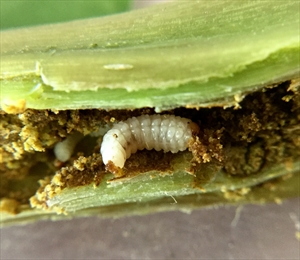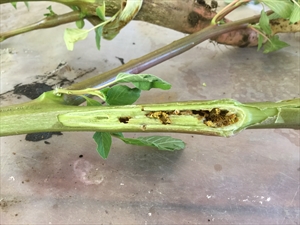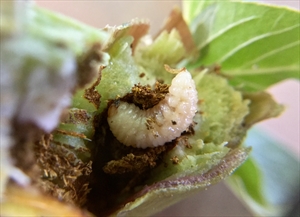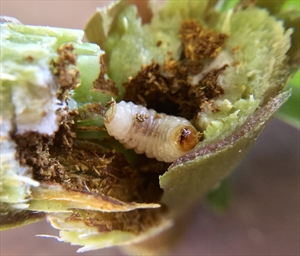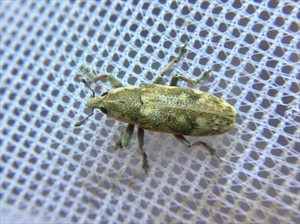Amaranthus stem weevil. Amaranthus weevil, pigweed weevil.
Pacific Pests, Pathogens and Weeds - Online edition
Pacific Pests, Pathogens & Weeds
Amaranthus stem weevil (351)
Hypolixus species. The species recorded by CABI1 are Hypolixus ritsemae, Hypolixus truncatus, and Hypolixus nublilosus. Hypolixus haerens is reported as the most common pigweed weevil in Kenya.
Hypolixus truncatulus (India, Mexico, Pakistan, and Thailand), Hypolixus ritsmae (Vanuatu), Hypolixus haerens (Kenya and South Africa), and Hypolixus nubilosus (Egypt and Kenya). The species in Fiji are unidentified.
Amaranthus species. In Fiji, the edible variety (Indian spinach or chauraiya) is Amaranthus viridis. Other hosts of Hypolixus species are Amaranthus spinosus, a noxious weed in more than 40 countries, and the many Amaranthus species referred as 'pigweeds'. In India, Hypolixus is also recorded feeding on Acacia, and Dalbergia (rosewood), and Hypolixus pica on almond in Turkey.
The grubs or larvae do the damage by boring through the central part of the stems and branches, which become filled with frass (Photo 1). Additionally, larvae and adults spread fungi (Fusarium species) that cause decay and cankers on branches, stems and at the root collar. Several larvae (20 to 30) occur in the same stem causing plants to weaken, wilt, split longitudinally, and sometimes die. Plants are also more susceptible to wind damage.
Of the several species reported, studies have been mostly on Hypolixus truncatulus in India. The symptoms and life cycle of this species are given here. Eggs are laid singly in holes in the stems, branches or leaf stalks, and plugged by a green secretion from the weevil. The eggs hatch and the grubs bore into the stems to feed on the pith making zigzag tunnels that become filled with frass (Photos 2-4). After about a month, and several moults, the larvae pupate in chambers at the base of the stem or at the lowest branch. Here galls form. Just before pupation the larvae burrow to the surface of the stem leaving all but the outer layer as a 'window' to the outside. Pupation lasts about two weeks (at 27°C) after which the adult emerges through the window left by the larva. Adults, up to 14 mm long, dark brown with patches of light brown (Photo 5). They feed on Amaranthus leaves.
Survival occurs in the remains of the harvested stems, and also in the stumps left in the soil. Spread occurs in (traded) infested stems, and also by adult weevils on the wing.
Hypolixus attack on Amaranthus can result in stunted, twisted plants, and cankers on the stems and branches. In India, Kenya and Mexico, Hypolixus weevils are considered important pests, and in many other countries a potentially important one where fast growing Amaranthus is gaining popularity as a nutritious vegetable. The impact of these weevils is increased by their ability to spread Fusarium species that cause stem and branch decay and cankers.
The damage is such that in some countries Hypolixus has been used as a biocontrol agent. CABI1 reports that Hypolixus truncatulus has been released in Thailand for the control of Amaranthus spinosus, a major weed of many crops. The releases have been so successful that the weevil may replace the use of herbicides for control of this weed.
Look for plants that are stunted, wilted, deformed; slit open the stems to find the tunnelling larvae in galleries filled with frass. Look for the adults on the foliage.
CULTURAL CONTROL
Before planting:
- Collect and destroy wild Amaranthus in the vicinity of cultivated crops.
-
Do not plant new Amaranthus crops next to those that are infested with the weevil.
During growth:
- Monitor crops regularly, and pull out and destroy any wilting plants.
After harvest:
- Collect and burn or bury as much of the crop as possible
CHEMICAL CONTROL
In India, boiled neem seed extract (5% w/v) is used as a spray on Amaranthus crops. Malathion has also been recommended. It is likely that plant-derived-products (botanicals), derris and pyrethrum would also be effective against adults, as would synthetic pyrethroids. However, it is doubtful that any of these products are likely to be effective against larvae and pupae concealed within stems and branches.
____________________
When using a pesticide, always wear protective clothing and follow the instructions on the product label, such as dosage, timing of application, and pre-harvest interval. Recommendations will vary with the crop and system of cultivation. Expert advice on the most appropriate pesticides to use should always be sought from local agricultural authorities.
AUTHOR Grahame Jackson
1Information CABI Amaranthus spinosus (spiny amaranth) (2019) Crop Protection Compendium. (https://www.cabi.org/cpc/datasheet/4653); and Tara JS (2009) Bionomics of Hypolixus truncatulus (f.) (Coleoptera: Curculionidae: Lixinae: Lixini), a major pest of Amaranthus caudatus L. Mun. Ent. Zool. Vol. 4(2). (https://www.munisentzool.org/yayin/vol4/issue2/510-518.pdf); and Chittora A (2015) Insect pests of amaranthus and moringa. (https://www.slideshare.net/AkshayChittora/insect-pests-of-amaranthus-and-moringa-53613459); and Rajeshkanna et al. (2017) Biology and management of Amaranthus stem borer (Hypolixus trancatulus) Coleoptera: Curculionidae). Annals of Sri Lanka Department of Agriculture 19: 258-266. (https://www.doa.gov.lk/images/ASDA/ASDA_2017awards/TechnicalPapers/VOLUME1/ASDA_book_set3/19_82%20Rajeskhanna%20Amaranthus.pdf); and from Blodgett J, et al. (2004) Identification of fungi and fungal pathogens associated with Hypolixus haerens and decayed and cankered stems of Amaranthus hybridus. Plant Disease 88: 333-337. (https://apsjournals.apsnet.org/doi/10.1094/PDIS.2004.88.4.3339). Photos 1-5 Mani Mua, SPC, Sigatoka Research Station, Fiji.
Produced with support from the Australian Centre for International Agricultural Research under project HORT/2016/185: Responding to emerging pest and disease threats to horticulture in the Pacific islands, implemented by the University of Queensland and the Secretariat of the Pacific Community.
